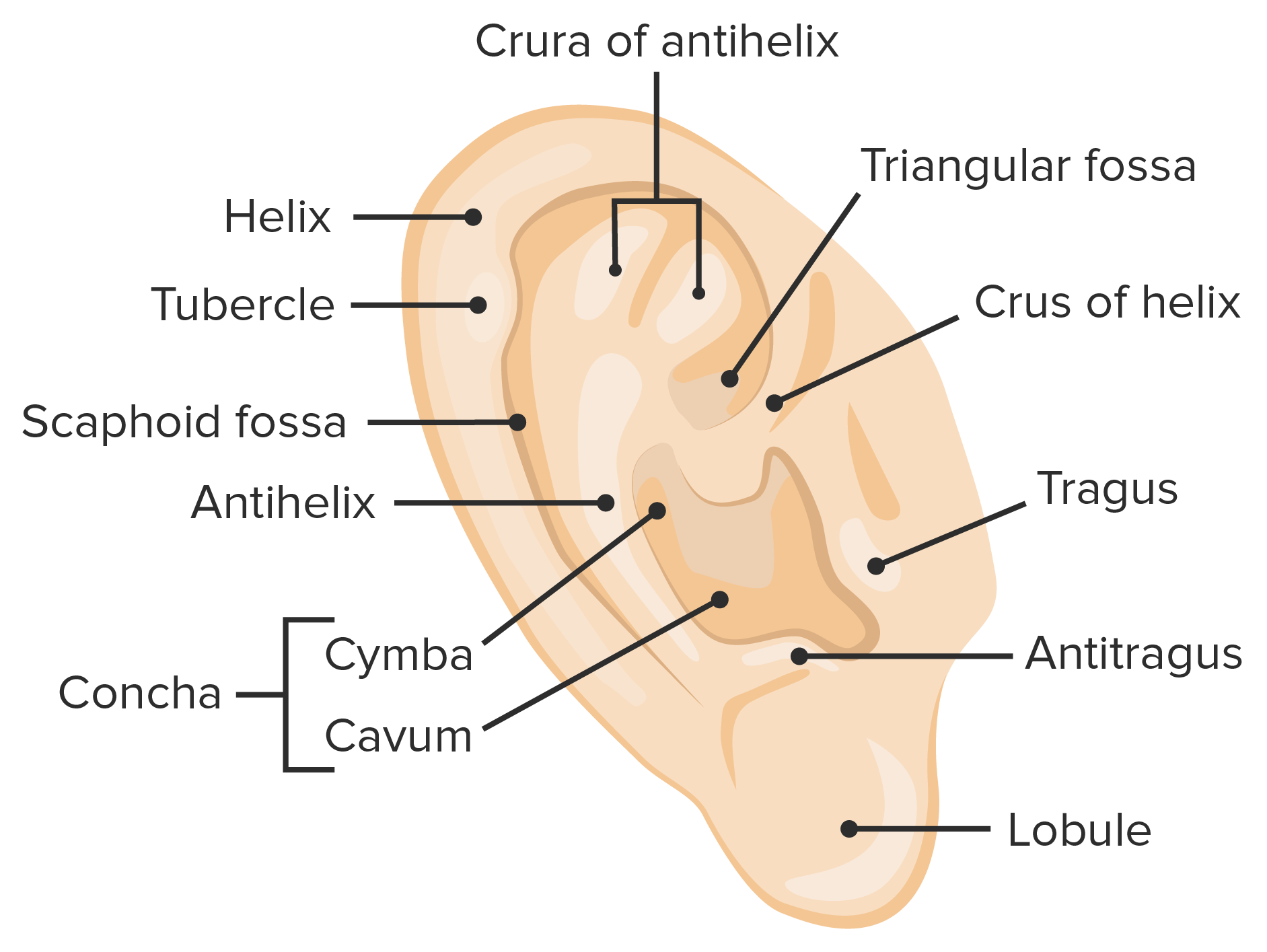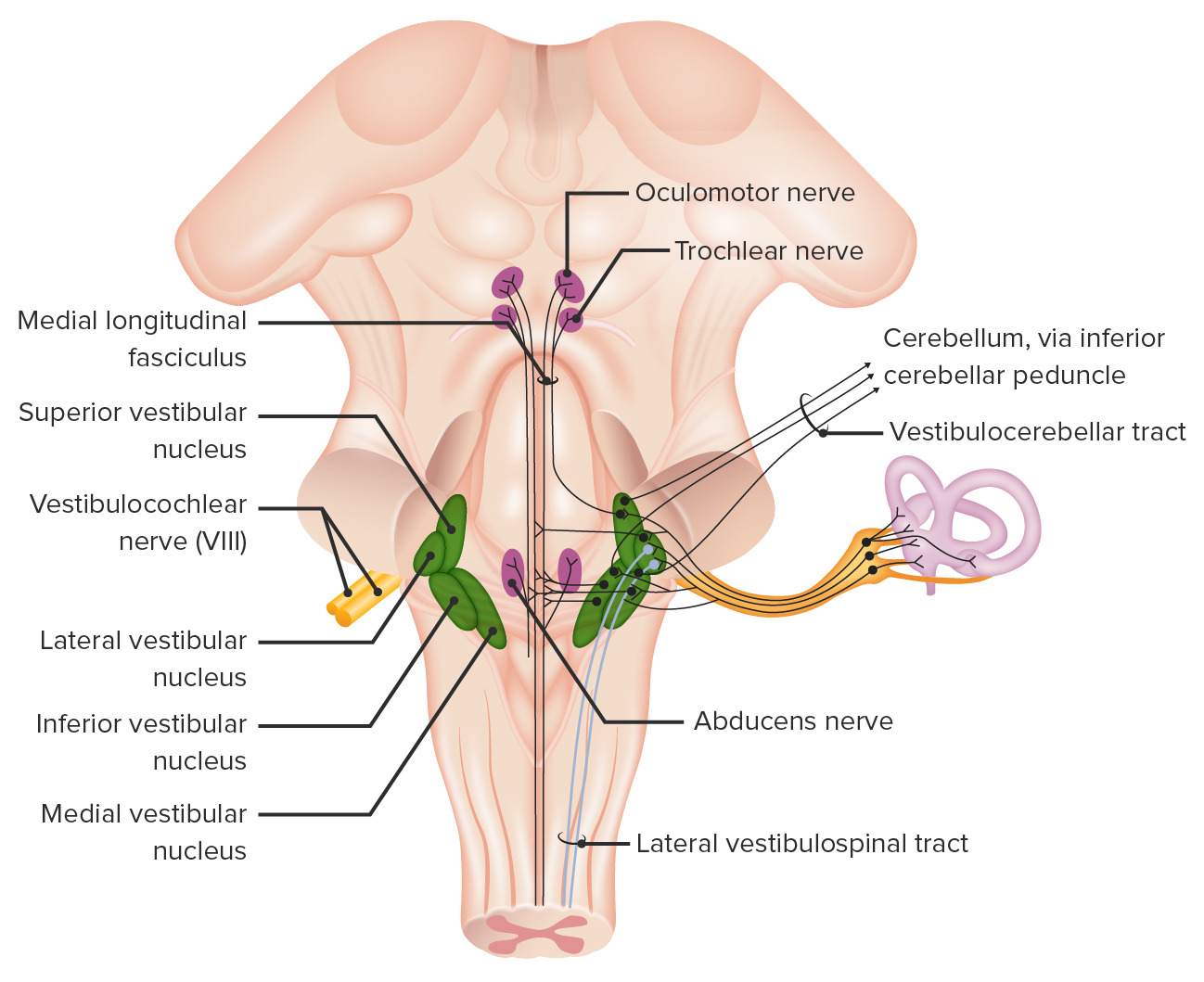Playlist
Show Playlist
Hide Playlist
Vestibular Nuclei
-
Slides 10 VestibularSystem 1 BrainAndNervousSystem.pdf
-
Reference List Anatomy.pdf
-
Download Lecture Overview
00:00 Transmission of vestibular action potentials that are initiated at the level of the hair cells will travel to the vestibular nuclei. It’s important for you to remember that there are four pairs of these vestibular nuclei associated in the brain stem. Here, we’re looking at the superior vestibular nuclei, so on this side and this side. 00:34 There are also lateral vestibular nuclei which are shown here and right over in through here. Then you have a third pair which are the inferior vestibular nuclei. That is shown here and over here. Then lastly, you have a pair of medially oriented vestibular nuclei. You see that one here and on the opposite side here. 01:07 Vestibular Nuclei, as mentioned in the previous slide, are located in the brain stem. Specifically, you’ll find them located in the medulla. Those that are oriented more superiorly will be found in the pons of the brain stem. Vestibular nuclei receive two inputs. The first would be the first order of afferents from the vestibular ganglion. So when the hair cells depolarize, those would be the first type of input to consider. 01:51 In addition, there’s an input from the cerebellum and specifically the flocculonodular lobe of the cerebellum will provide that cerebellar input into the vestibular nuclei. Vestibular nuclei have outputs. 02:15 The first thing that’s essential here is that cranial nerve outputs from the cranial nerve nuclei. 02:22 These axons are going to travel in a structure referred to as the medial longitudinal fasciculus that is labeled in through here right along this hashed line on this side. You see the medial longitudinal fasciculus along the hashed line there as well. Important cranial nerve nuclei would be the oculomotor nuclei. 02:51 We see one nucleus here on this side and the other is shown here. Trochlear nerve nuclei right in through here and over here on the opposite side and then you can see the trochlear nerve associated with these nuclei as well. The abducens or abducens nucleus is shown at this level on this side and then you see it on this side. In addition, we have outputs to the thalamus. There's a reciprocal output to the cerebellum back to the flocculonodular lobe. So there's an input from this flocculonodular lobe and then there’s an output, so reciprocal circuitry is found here. Then to help us maintain our equilibrium and balance, there has to be a communication to skeletal muscles that are involved in the maintenance of our balance. There are descending tracts, motor tracts to include the lateral vestibulospinal tract as well as the medial vestibulospinal tract. Here are some functional considerations of these various outputs for you to understand. We have a nice table here that has been developed. So, we can go through this one by one. First is the functional consideration of cranial nerve nuclei. This will help control eye movements in association with the maintenance of balance and equilibrium. The purpose of the output from the thalamus is again, this is the gateway of consciousness. This allows us to have a conscious perception of movement and gravity through the thalamic connections to the cortex. The output to the cerebellum specifically the flocculonodular lobe is to enter a coordination of our postural adjustments. The lateral vestibulospinal tract, that is functionally important for allowing us to walk in an upright position. 05:25 Then the medial vestibulospinal tract, this output assists us in integrating head and eye movements.
About the Lecture
The lecture Vestibular Nuclei by Craig Canby, PhD is from the course Auditory System and Vestibular System.
Included Quiz Questions
In which of the following structures are vestibular nuclei located?
- Medulla
- Midbrain
- Limbic system
- Basal ganglia
- Cerebellum
Which of the following structures sends and receives signals through the vestibular nuclei.
- Flocculonodular lobe
- Thalamus
- Vestibular ganglion
- Lateral vestibulospinal tract
- Medial vestibulospinal tract
Vestibular nuclei produce output to the cranial nerves to achieve control over certain functions. Which function is mediated by the fibers sent to the oculomotor nerve?
- Eye movements
- Coordination of postural adjustments
- Walking upright
- Head movements
- Conscious proprioception
For a person to be able to walk upright, vestibular output to which of the following structures is necessary?
- Lateral vestibulospinal tract
- Cranial nerve nuclei
- Cerebellum
- Thalamus
- Medial vestibulospinal tract
Customer reviews
3,0 of 5 stars
| 5 Stars |
|
1 |
| 4 Stars |
|
0 |
| 3 Stars |
|
0 |
| 2 Stars |
|
0 |
| 1 Star |
|
1 |
nice concise summary of lecture and topic. I enjoyed it very much and it kept me attentive!.
More voice inflection and emphasis on terms and anatomic function please.





